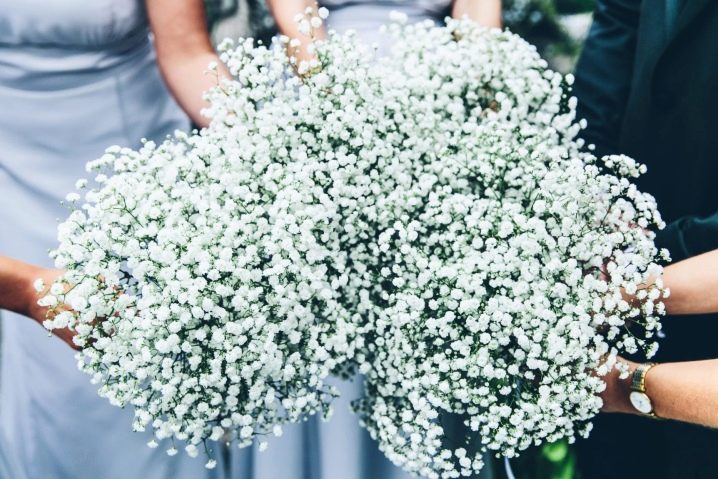All about white gypsophila

Delicate and airy clouds of green bushes with many small white flowers, which florists often use in bouquets, can grow well in an ordinary garden. This gypsophila is a charming and at the same time unpretentious plant that takes root well in our climate.

general description
Gypsophila (kachim) is an annual, biennial or perennial herbaceous shrub of the Clove family. This shrub has a spherical shape and grows, as a rule, in the open field.
Gypsophila stems are thin, densely branching from the very base. Leaves are linear-lanceolate or lanceolate, sessile at the very stem, have a bluish-green tint. The edges of the leaves are solid, with a pointed tip and easily distinguishable veins. The color and shape of the inflorescences depend on the specific species, but the flowers themselves are always modest in size.
Gypsophila is a dried-flower plant, which means that its flowers, after drying, do not lose their attractiveness, therefore florists often use them to decorate bouquets.

Popular varieties
In total, there are more than 150 varieties of kachima, including wild ones. All of them can be divided into four main types.
Paniculata
The most common species, distinguished by the larger size of the flowers and the bush itself. Such a perennial plant looks like a large openwork ball with paniculate inflorescences covering the stems. Popular varieties of paniculate gypsophila are terry, "Snowflake", "Bristol Fairy".

Graceful
An annual shrub of a more modest size, the stems of which branch slightly more than those of paniculate species. It has openwork thyroid panicles of inflorescences, which, unfortunately, have a short flowering period.
The most popular variety of graceful gypsophila is “Bridal Veil”.

Creeping
Low bushes up to 30 cm have the densest branching, which makes it possible to use this species as a ground cover. The leaves are darker in color, due to which the small snow-white buds stand out even brighter against their background. The most popular variety of creeping gypsophila is Monstroza.

Jascolkovid
A rare Himalayan species of creeping kachima, which has the smallest height of bushes - only 10 cm. It takes root quite hard in the middle lane and does not bloom for the first few years. But if an experienced gardener manages to preserve such a gypsophila, the exotic white-pink shade of the petals with bright streaks will delight the eyes of others for a long time.

Landing
Despite the unpretentiousness of gypsophila, the place for planting it should be chosen wisely. An open and well-lit garden area with light and fertile soil is best suited for this. It is good if the groundwater goes deep enough in this place, and the soil is thoroughly loosened in advance. Lime soil, sandy loam or even loam is ideal.
It is best to germinate seedlings in a pot or greenhouse in the first half of spring, and it is recommended to transplant gypsophila into the ground at the beginning of summer.
But you can also do with direct planting of seeds in the ground, while the losses will not be too strong.

Care
Kachim is frost and drought resistant, does not require special attention from the gardener and is content with basic care.
-
Watering is needed only in the hottest weather, no more than once every 5-7 days, and is done as the soil dries up using the root method.
-
Gypsophila is fed 2-3 times per season with manure or compost, and only if it looks weak or sick. Fresh organic matter cannot be used as fertilizer.
-
Before winter, the gypsophila is cut to small stumps, and the soil above the roots is sprinkled with straw or leaves. With enough snow, it will survive even the most severe frosts.

Reproduction
Gypsophila is propagated:
-
seeds;
-
division;
-
cuttings.
Seeds are best sown in April under a protective film. Cuttings are cut from young stems on which flowers have not yet formed, in April or May.
And the abundantly overgrown shrub can be divided into several parts either in March or in September.

Diseases and pests
Kachim quite often suffers from fungal diseases and brown bloom, especially if the season is wet. To get rid of this problem, you need to spray or water it with fungicides, for example, "Oxyhom" or copper sulfate.
Of the harmful insects, the shrub is most often annoyed by the nematode, the fight against which requires spraying with "Phosphamide". If "Phosphamide" did not help, you can dig up the gypsophila and rinse its roots in hot (at least 40 degrees) water.

Application in landscape design
Gypsophila looks harmoniously next to a variety of bright or pastel colors, and as an independent decorative element. That is why the scope of its application in landscape design is quite wide.

First of all, it serves as an excellent background for other plants in various flower beds, rose gardens and even open rock gardens. Moreover, it can be used as a central accent of landscape composition.

With its help, you can arrange any curbs, paths and nooks of the garden.
Creeping varieties can cover empty areas, cover low embankments and mounds.

And also gypsophila can be used as vertical gardening of a veranda or gazebo. Of course, it will not be able to completely replace the grapevine or hops, but it will look much more original than the usual bindweed.












The comment was sent successfully.